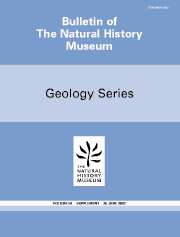Article contents
Upper Ordovician brachiopods from the Anderken Formation, Kazakhstan: their ecology and systematics
Published online by Cambridge University Press: 12 June 2002
Abstract
Synopsis 13
Introduction 13
Outline of geology and fossil localities 14
Faunal Associations 22
Overall palaeoecology 26
Systematic palaeontology 27
Linguloidea 28
Discinoidea 28
Siphonotretoidea 30
Craniopsoidea 30
Strophomenoidea 30
Plectambonitoidea 38
Chilidiopsoidea 53
Triplesioidea 53
Protorthoidea 58
Orthoidea 58
Plectorthoidea 61
Enteletoidea 64
Camarelloidea 64
Rhynchotrematoidea 74
Lissatrypoidea 76
Meristelloidea 76
Acknowledgments 77
References 77
The brachiopod fauna from the Anderken Formation (Lower to Middle Caradoc) of the Chu-Ili Range, south-eastern Kazakhstan, is revised and described systematically. It consists of 62 species in 55 genera, of which the genera Tesikella, Olgambonites and Zhilgyzambonites (all Plectambonitoidea) and Ilistrophina (Camarelloidea) are new, and the species Bellimurina (Bellimurina) sarytumensis, Teratelasmella chugaevae, Foliomena prisca, Acculina kulanketpesica, Dulankarella larga, Kajnaria rugosa, Anoptambonites convexus, Olgambonites insolita, Zhilgyzambonites extenuata, Gacella institata, Placotriplesia spissa, Grammoplecia wrighti, Dolerorthis pristina, Austinella sarybulakensis, Plectorthis? burultasica, Bowanorthis? devexa, Pionodema opima, Parastrophina iliana, Ilistrophina tesikensis, Liostrophia pravula, Plectosyntrophia unicostata, Rhynchotrema akchokense and Nikolaispira guttula are new. Six brachiopod-dominated assemblages are recognised and defined, termed the Ectenoglossa, Tesikella, Mabella–Sowerbyella, Acculina–Dulankarella, Parastrophina–Kellerella and Zhilgyzambonites–Foliomena Associations. The relationships with contemporary faunas are assessed, and the Anderken brachiopods appear to have much in common with those of north-west China.
- Type
- Research Article
- Information
- Bulletin of the Natural History Museum: Geology Series , Volume 58 , Issue 1 , 27 June 2002 , pp. 13 - 79
- Copyright
- © The Natural History Museum, 2002
- 16
- Cited by


